Episode 49: Q&A: Changing Horse’s Habits, Sell or Keep, Hobble Training and Riding Bareback
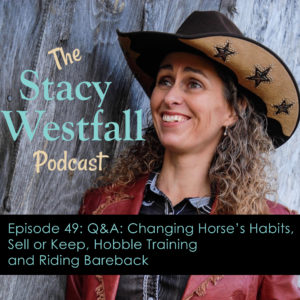
I tackle four different listener questions today. If you would like to ask a question or have a topic you would like me to expand on please hit the orange tab on the side and leave a voicemail. You just might end up in one of my future podcasts. Fun facts about today’s listener questions include two come from France, two of the listeners have the same name, and one is 12 years old. The first thing I talk about is whether it’s possible to delete a bad habit. I talk about how layers of training apply, understanding the horse’s nature, and how important it is to understand why a horse is doing something.
Then we move on to a question about whether it’s a good idea to keep a needy fearful mare. I share the questions that this listener really needs to ask herself to find the answer that suits her lifestyle. Then we move on to hobble training. I talk about the pros, cons, safety, and alternatives. The last question is from a young listener who just wants tips and advice on riding bareback. I share my childhood experience and then my more advanced experience with riding Can Can Lena. This episode closes out this season, and I’ll be talking about tools in the upcoming season.
“I knew I needed to find a way to love working with whatever horse I was training.” Stacy Westfall Click To TweetShow Notes:
[00:43] Sophie from France is trying to help a friend who has no control of her horse and falls off of the saddle regularly. She wants to know if it’s possible to delete a bad habit that’s in the horse’s mind.
[01:41] Adding layers to the horse’s training applies here, but there are also a couple of other angles.
[01:52] What is in the horse’s nature? Not all horses tend to lean towards a certain behavior. A horse that bucks in the pasture would have more of a natural tendency to buck.
[03:03] The example I like to use often is a horse that will rear when you see it playing is a little easier to get that horse to rear when you’re doing groundwork and liberty work because it kind of already has a habit of liking to do that.
[03:40] Does a horse buck because it’s in his nature or is it because he’s scared?
[03:51] A lot of horses will exhibit undesirable behavior because of fear. If a horse doesn’t understand something, it may use an undesirable behavior as an escape route.

[04:31] If a horse is doing something out of fear, that leaves you more room for correcting it or adding layers on top of it.
[05:10] Living a life without fear is so much more enjoyable for the horse.
[05:32] You can also ask if this is Grandma’s rules, but this typically means that the horse will behave one way with one person and in a different way with another person.
[09:11] The way you label the behavior will change how you behave with the horse.
[10:03] Recognize who the horse is at their core. Their core doesn’t change.
[10:41] You might be able to train this horse and never see it again. It really comes down to the root cause.
[10:50] A listener adopted a very needy mare who is fearful and buddy sour. Her emotions are so high, the listener can’t get the horse to respond to her. The listener is afraid the horse’s ground behavior will translate to the saddle, and she wants to trail ride the horse.
[11:42] Will the horse get over this with training? Should she send it back?
[12:16] This really comes down to the listener’s personal situation. You need to get clear about what you want and if this horse fits with what you want.
[13:28] Does this look like a fun project for you?
[14:39] Are you interested in finding out why this horse thinks this way? Do you want to solve the puzzle of this horse who has high emotions?
[15:13] There are a lot of variables of how things could turn out with this horse. Write down the way things could play out and see if most are negative or positive.
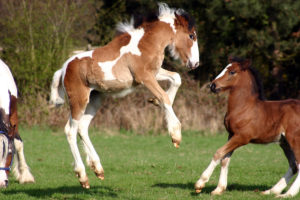
[17:07] There is a piece of the horse telling you about her nature. There’s a lot we can do to modify their nature especially if the horse is lacking training.
[17:23] If your not excited about being the person who puts in hundreds of hours without knowing if it will work or not, then you won’t have fun doing it.
[18:01] Think in the zone of the rider’s mind and don’t let there be any shame if it’s not for you.
[19:25] Everything can improve with training. You need to decide how high a priority trail riding is.
[20:45] Clair from France has a question regarding hobble training. She’s getting a new colt this fall and wants to hobble train him along with her 5-year-old.
[21:24] Hobbling can be a good skill or a train wreck.
[22:02] Horses fight with hobbles because they are scary.
[22:33] You can teach horses to lead from each leg. Teach a horse to give to pressure, then when you go to hobble training it’s already done for you.
[24:17] If a horse gets tangled up in something, they will give to that pressure instead of fighting against it.
[26:07] Hobble trained horses don’t struggle if they get tangled in something.
[26:50] It can also be a disaster if not prepared correctly.
[31:51] Ground tying a horse a teaching them the mental aspect of staying put is another option.
[32:06] Make sure the horse understands giving pressure to each leg.
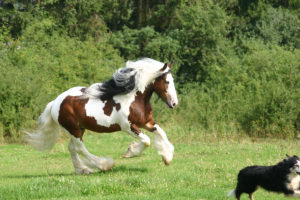
[32:41] Consider why you want to do it and the nature of the horse. Make it a great experience.
[33:06] We have another question from a 12-year-old Claire in Texas. She rides bareback a lot and wants tips on balancing and bareback in general.
[33:26] I grew up riding bareback. I have slid down the horse’s neck and landed in front of her face when the horse has stopped to eat grass.
[34:22] In 2004, I started riding Can Can Lena bareback. She went back to start small in a short amount of time and build up.
[35:03] I would ride like normal and then cool her down by pulling the saddle off and riding bareback.
[36:47] Riding bareback feels different for the horse, and they might ask questions.
“If at your core, you believe the horse is too much to handle then you need to admit that.” Stacy Westfall Click To Tweet
Links and Resources:
Episode 31: Listener Question: Untraining a Horse or Adding Layers?
Stacy Westfall 2003 NRHA Futurity Freestyle Bridleless Reining
2 Comments
Leave a Comment
SUBSCRIBE TO THE PODCAST HERE:
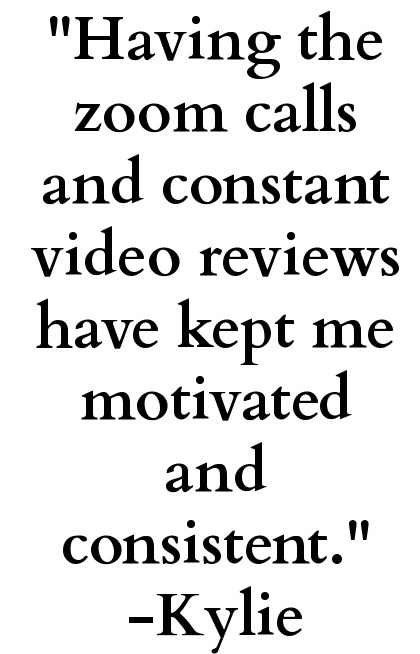
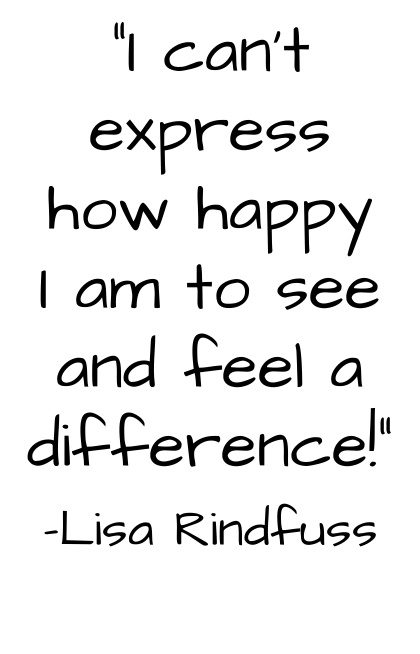
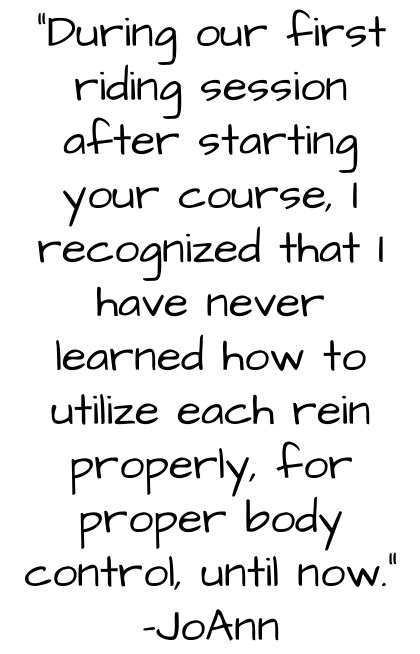
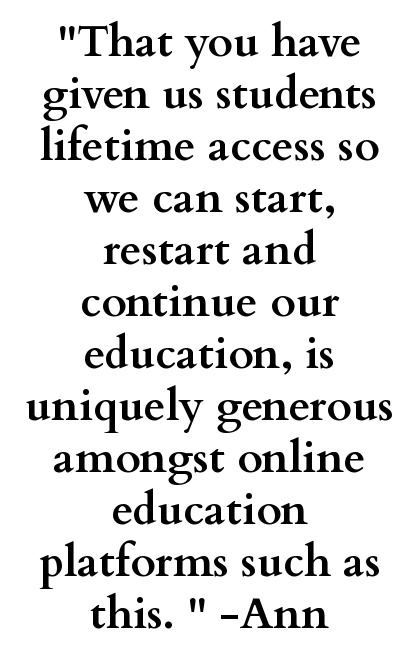
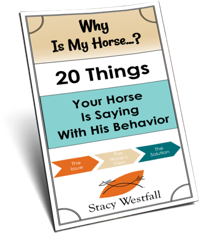
YOURS FREE
WHY IS MY HORSE...?




This episode, particularly the 2nd listeners question made me feel as though she was asking a question for me, and you, Stacy, were speaking TO ME. This is a little winded, and I promise, this is the short version!
I had a mare that I bought as a 10 year old and started under saddle myself. When i got her she already knew how to lunge on a loose line, trailered well, and stood still for a farrier.
95% of the time she did very well when I was riding her, but every now and then she would explode and buck….HARD. She had thrown me off right before I heard this episode. After hearing what you said about admitting to myself that she may be too much for me, I sat with your words for a few months. I made a mental list of pros and cons of keeping her vs. selling her. She is the 6th or 7th horse I’ve started myself, so admitting to myself that she was too much was a hit on my pride. Then this past summer I was riding her…you guesssed it, she dumped me again. Although I was able to get up and walk immediately, all I could think about was that I have two beautiful children, and they need their mom to be alive, and functional. I also thought about how I did not want to keep her as a pasture pet, so the option I narrowed down to was to find a new home for her.
After calling an equine dentist out to our farm on an unrelated matter, the dentist met this mare and fell in love with her. We talked about her bloodlines (which are very desirable/valuable in the barrel racing world)and that I was looking for a home for her. I’m happy to say that mare is now with the dentist and gets to live out the rest of her days as a broodmare.
When I saw your email about this contest, this episode/story is the first thing I thought of. You really helped me get over those hard emotional decisions, and I’m completely at peace with the decision I made. Thank you!
This was a great Podcast!! So much great info!
I LOVE Popcorn!!! Your horse and the delicious snack!
Have a great day!
Jenny